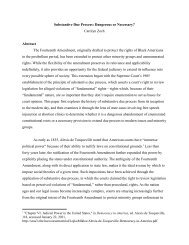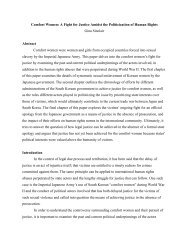Brown Undergraduate Law Review — Vol. 2 No. 2 (Spring 2021)
We are proud to present the Spring 2021 issue of the Brown Undergraduate Law Review. We hope that the works contained herein offer insight and inspiration to all who read them.
We are proud to present the Spring 2021 issue of the Brown Undergraduate Law Review. We hope that the works contained herein offer insight and inspiration to all who read them.
Create successful ePaper yourself
Turn your PDF publications into a flip-book with our unique Google optimized e-Paper software.
The Failure of the Treatment of Low-Level Offenders in the Juvenile Justice System<br />
resources. 48<br />
including different common spaces. This is to prevent<br />
children from abuse and physical assault by adults.<br />
<strong>No</strong>t only is detention detrimental for youths?mental health,<br />
Similarly, placing low-risk juveniles in detention exposes<br />
it is also ineffective for rehabilitation. There is no greater<br />
youth to others who have committed actual violent<br />
predictor of future incarceration than previous detention,<br />
even as compared to gang membership, weapons, or a poor<br />
parental relationship. 49 Detention inherently pulls youth<br />
crimes. 56 These interactions may be a strong factor of<br />
increased recidivism rates. 57<br />
further into both the juvenile and later criminal justice Overall, incarceration is costly and ineffective<br />
system. A study found that the incarceration of juveniles<br />
for truancy had no effect on later school attendance. 50<br />
Detained juveniles, who do not re-offend and have no<br />
subsequent interaction with the criminal justice system, are<br />
still up to 40 percent less likely to graduate, and have<br />
reduced success in future earnings. 51 52 Exposure to<br />
juvenile court, even without incarceration, increases crime<br />
rates in young adulthood threefold. 53<br />
rehabilitation, especially for low-level offenders. However,<br />
with the rise of school shootings, zero-tolerance policies,<br />
and the hysteria of juvenile superpredators, every state has<br />
changed their laws in some way to make it easier to<br />
incarcerate youth in the last 30 years. 58 Despite the<br />
abundance of research against and the cost of juvenile<br />
detention, more than 48,000 youth are currently confined<br />
in facilities away from home. 59<br />
While detention is detrimental for all youth, the risk is<br />
greatest for youth incarcerated for status offenses and<br />
technical violations. A meta-analysis of risk in juvenile<br />
detention found that intensive supervision had no effect on<br />
rehabilitation and increased recidivism rates for some low<br />
risk offenders. 54 This can be explained through the same<br />
logic of sight and sound separation for juvenile offenders.<br />
Sight and sound separation requires juveniles placed in<br />
adult jails or prisons to be separated by ?sight and sound,?<br />
Informal and Flexible Procedures<br />
The child-savers assumed that the government would have<br />
the best interests of youth in mind. Therefore, due process<br />
protections were not extended to juvenile delinquency<br />
proceedings, which were considered civil instead of<br />
criminal proceedings.<br />
In 1967, President Lyndon Johnson?s Commission on <strong>Law</strong><br />
Enforcement and Administration of Justice released a<br />
48. Rani A. Desai et al., "Mental Health Care in Juvenile Detention Facilities: A <strong>Review</strong>." Journal of the American Academy of Psychiatry and the<br />
<strong>Law</strong> Online 34 (June 2006): 204.<br />
49. Holman and Ziedenberg.<br />
50. Dean Hill Rivkin, ?Truancy Prosecutions of Students and the Right [to] Education,? Duke Forum for <strong>Law</strong> & Social Change, (2011), 139-161.<br />
51. John Whibey, ?Juvenile incarceration and its impact on high school graduation rates and adult jail time,? Journalist?s <strong>Review</strong>, (2015).<br />
52. Holman and Ziedenberg.<br />
53. Uberto Gatti, et al., ?Effects of juvenile court exposure on crime in young adulthood.? Journal of Child Psychology and Psychiatry, vol. 54, no. 3,<br />
(2013), 291-297.<br />
54. Edward J. Latessa and Christopher T. Lowenkamp, ?Understanding the Risk PrincipleL How and Why Correctional Interventions Can Harm<br />
Low-Risk Offenders,? Topics in Community Corrections, (2004).<br />
55. The Coalition for Juvenile Justice, ?Sight and Sound Separation,?<br />
https://www.juvjustice.org/juvenile-justice-and-delinquency-prevention-act/sight-and-sound-separation.<br />
56. Latessa and Lowenkamp.<br />
57. McNelly, 117.<br />
58. Holman and Ziedenberg.<br />
59. Sawyer.<br />
<strong>Brown</strong> <strong>Undergraduate</strong> <strong>Law</strong> <strong>Review</strong><br />
14










